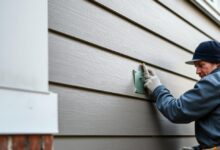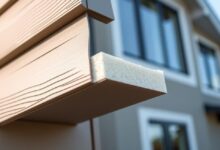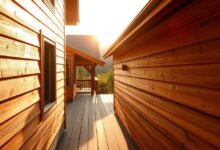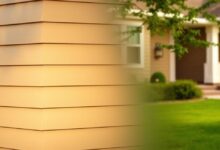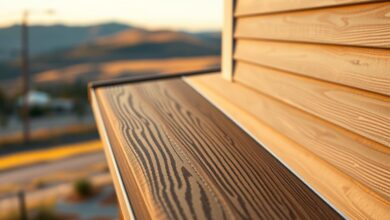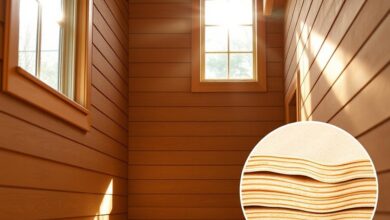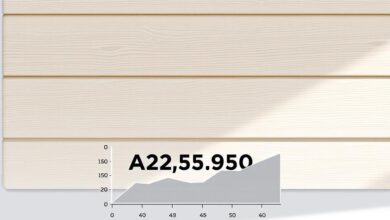Insulate Your Home with the Best Siding
Keeping your home well-insulated is key to a cozy living space and saving on energy bills. The right siding can make a big difference. It helps keep your home warm in winter and cool in summer.
Choosing the best siding for home insulation means looking at its insulation ratings. This choice helps make your home more energy-efficient. It also lowers your utility bills and reduces your carbon footprint.
Key Takeaways
- Proper home insulation reduces energy costs.
- The right siding improves home energy efficiency.
- Insulation ratings are key when picking siding.
- Energy-efficient homes save on utility bills.
- A well-insulated home cuts down on carbon footprint.
The Impact of Quality Siding on Home Energy Efficiency
Home energy efficiency is greatly influenced by the type and quality of siding. Quality siding not only makes a home look better but also helps save energy.
How Siding Functions as an Insulation Barrier
Siding acts as an insulation barrier, keeping homes safe from extreme temperatures. It helps keep the inside temperature steady, reducing the need for more heating or cooling. Modern siding materials are made to seal well against air leaks, making them better insulators.
Energy Loss Through Poorly Insulated Walls
Poorly insulated walls can cause a lot of energy loss. Without enough insulation, heated or cooled air gets out, making HVAC systems work harder. This raises utility bills and can wear out heating and cooling systems faster.
| Siding Type | Insulation Properties | Energy Efficiency Impact |
|---|---|---|
| Insulated Vinyl Siding | High insulation value | Significant reduction in energy loss |
| Fiber Cement Siding | Moderate insulation | Moderate energy efficiency improvement |
| Engineered Wood Siding | Variable insulation | Potential for energy efficiency gains with proper installation |
Understanding Insulation Ratings for Siding Materials
Knowing the insulation rating of siding materials is key for homeowners wanting to save energy. Insulation ratings show how well siding blocks heat flow. This affects a home’s energy use.
Decoding R-Values and Their Importance
R-values measure how well siding keeps heat out. A higher R-value means better insulation. For example, insulated vinyl siding is now popular because it has a higher R-value than regular vinyl siding.
Choosing siding with the right R-value is important. It helps meet your home’s energy needs.
Recommended Insulation Levels for Different US Climate Zones
The US has different climate zones, each needing its own insulation level. The Department of Energy gives guidelines for these levels.
Northern States Requirements
In cold climates, like the northern states, you need siding with high R-values. This keeps your home warm and lowers heating costs.
Southern States Considerations
In warmer climates, like the southern states, keeping homes cool is key. While R-value matters, siding that reflects sunlight is also important.
Midwest and Variable Climate Regions
The Midwest has cold winters and warm summers. Siding here needs to handle both. A balanced insulation approach is needed.
| Climate Zone | Recommended R-Value | Siding Material Considerations |
|---|---|---|
| Northern | R-20 to R-30 | Insulated vinyl, fiber cement |
| Southern | R-10 to R-20 | Reflective siding, insulated vinyl |
| Midwest | R-15 to R-25 | Insulated vinyl, engineered wood |
Best Siding for Home Insulation: Material Comparison
The siding you pick can really affect how warm or cool your home stays. There are many siding types, each with its own insulation level. It’s key to look at how well they keep heat in or out.
Insulated Vinyl Siding Systems
Insulated vinyl siding is a top pick for many homeowners. It has a vinyl outer layer and foam inside for better energy use. This siding is durable and easy to care for, which is why it’s so popular.
Fiber Cement Siding Options
Fiber cement siding is another good choice for better insulation. It’s made from cement, sand, and wood fibers. It’s strong against pests and fire. It’s not as insulating as vinyl, but it’s durable and looks good.
Engineered Wood Composite Products
Engineered wood siding is made to keep your home warmer or cooler better than regular wood. It’s made from wood fibers and glue. It looks natural and insulates well, making it a smart choice.
When picking siding, think about your climate, budget, and what you like. Looking at insulation levels of different materials helps you choose wisely. This way, you can make your home more energy-efficient.
Insulated Vinyl Siding: America’s Popular Choice
Insulated vinyl siding is loved in America for its great thermal performance and style. Homeowners want siding that saves energy and looks good. This demand has grown as people focus more on saving energy.
Structure and Thermal Properties
Insulated vinyl siding has a foam backing for extra insulation. This helps keep the inside of your home warm in winter and cool in summer. It’s a smart choice for those who want to cut down on energy costs.
Brand Options and Performance Differences
There are many insulated vinyl siding options from different makers. Brands like CertainTeed and Mastic are known for their quality. They have products for various needs and budgets.
Entry-Level Insulated Products
Entry-level insulated vinyl siding is a budget-friendly option. It offers basic insulation benefits at a lower cost.
Premium Insulated Systems
Premium insulated vinyl siding systems have better thermal performance and last longer. They’re for those who want top-notch siding.
Installation Requirements
Getting insulated vinyl siding installed right is key. It’s best to hire experts who know how to install it properly. This ensures it works as it should.
Fiber Cement and Engineered Wood: Alternative Insulators
Homeowners looking for something other than vinyl siding might consider fiber cement and engineered wood. These options are durable, look good, and keep your home warm or cool.
James Hardie and Other Fiber Cement Options
James Hardie fiber cement siding is known for lasting long and standing up to the weather. It’s a mix of cement, sand, and cellulose fibers. This gives it a strong, lasting finish.
- High resistance to fire, pests, and rot
- Low maintenance requirements
- Available in various styles and textures
LP SmartSide and Engineered Wood Products
LP SmartSide engineered wood siding is designed to be tough and not warp or crack. It’s made from wood strands glued together.
- Cost-effective compared to some other siding materials
- Environmentally friendly due to the use of wood strands
- Can be painted or stained to match any home style
Both fiber cement and engineered wood siding are great for keeping your home warm or cool. They also add beauty to your home. So, they’re good choices for improving your home’s energy use and looks.
Cost Analysis and Return on Investment
Deciding to invest in insulating siding means looking at both the initial costs and long-term savings. Homeowners need to compare the upfront costs with the energy savings and increased property value.
Initial Investment for Different Insulating Siding Types
The cost of insulating siding changes based on the material. For example, insulated vinyl siding is usually cheaper, costing between $3 to $7 per square foot. On the other hand, fiber cement siding and engineered wood are pricier, with costs ranging from $5 to $10 per square foot, and $4 to $8 per square foot, respectively.
| Siding Material | Cost per Square Foot | Installation Cost |
|---|---|---|
| Insulated Vinyl Siding | $3 – $7 | $4 – $8 |
| Fiber Cement Siding | $5 – $10 | $5 – $10 |
| Engineered Wood | $4 – $8 | $5 – $9 |
Long-Term Energy Savings and Payback Periods
The initial cost of insulating siding is high, but the long-term savings are worth it. The
“U.S. Department of Energy says homeowners can save $200 to $500 a year on energy bills by improving insulation and air sealing.”
The time it takes to recoup the investment depends on the siding material, local energy costs, and climate. Insulated vinyl siding usually pays off in 5 to 10 years. More durable options like fiber cement may take longer but offer more value in the long run.
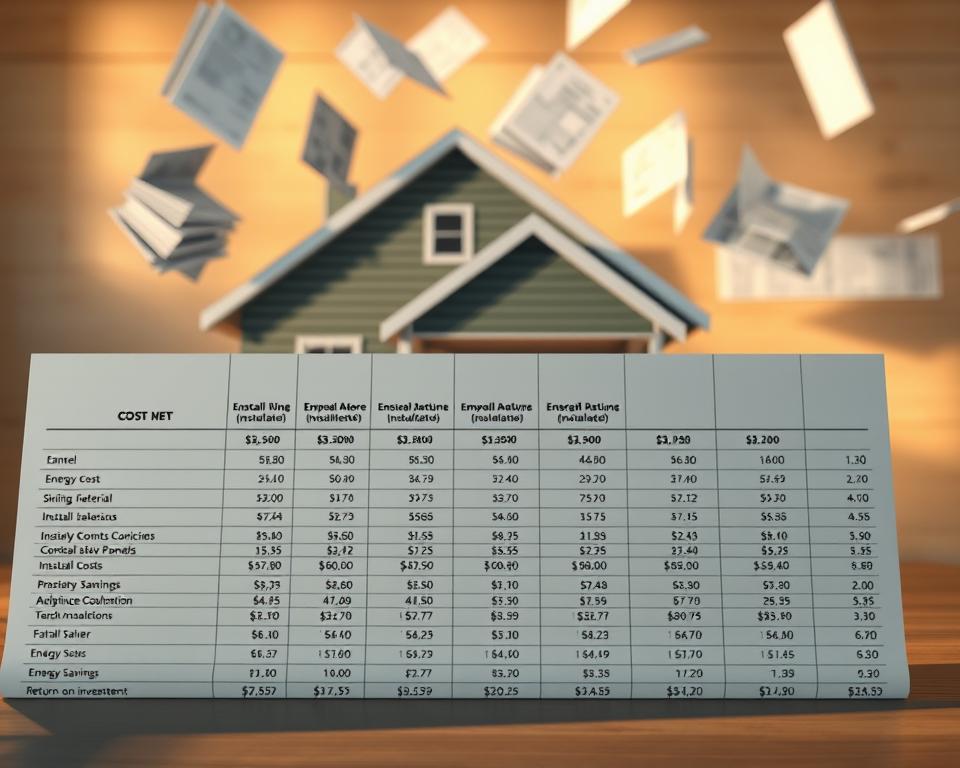
By looking at the costs and benefits, homeowners can decide if insulating siding is a good investment for their property.
Installation and Maintenance for Optimal Insulation Performance
Getting your siding installed right and keeping it up is key. A good siding system makes your home more energy-efficient. It also helps your home last longer.
Professional Installation Best Practices
Having a pro install your siding is essential. They make sure the siding fits right, is securely fastened, and seals all edges. This stops air leaks.
It’s also important to follow the manufacturer’s instructions and local building codes. This keeps your warranty valid and ensures you’re following the rules.
Maintenance Requirements by Material Type
Each siding material needs different care. Knowing what your siding needs helps keep it working well.
Vinyl Maintenance Schedule
Vinyl siding needs a gentle clean with soap and water to keep it looking good. Check it every year for any damage or gaps.
Fiber Cement Care
Fiber cement siding should be checked for cracks or damage often. You should repaint it every 10-15 years to keep it protected.
Engineered Wood Upkeep
Engineered wood siding needs regular checks for wear or damage. You should re-coat it with a protective finish every 5-7 years to keep it looking and lasting good.
Conclusion: Selecting the Right Insulating Siding for Your Home
Choosing the right siding for your home is very important. It affects how energy-efficient and comfortable your home is. Insulated vinyl siding is a top pick in the US for its insulation.
Think about your climate, budget, and how easy it is to maintain when picking siding. Brands like James Hardie and LP SmartSide offer great options. They balance the cost upfront with long-term savings on energy.
Getting professional help to install your siding is essential. The right installation can cut down on energy loss. This makes your home more energy-efficient. Knowing about different siding materials and what you need can help you choose wisely. This choice will make your home more comfortable and save you money on energy.

